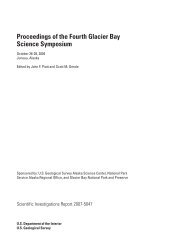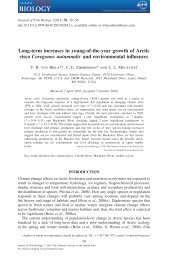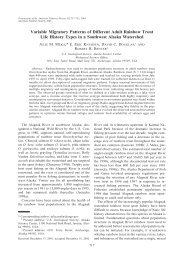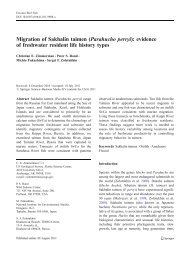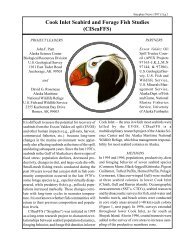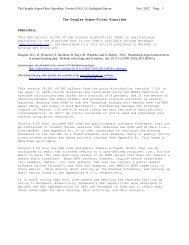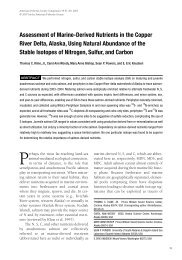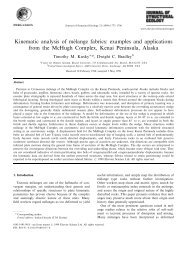Mexican native trouts: a review of their history and ... - Webspace
Mexican native trouts: a review of their history and ... - Webspace
Mexican native trouts: a review of their history and ... - Webspace
Create successful ePaper yourself
Turn your PDF publications into a flip-book with our unique Google optimized e-Paper software.
276<br />
Figure 1. Distribution <strong>of</strong> <strong>native</strong> or potentially <strong>native</strong> <strong>trouts</strong> in northwestern Mexico. All drainages from which trout collections are known are<br />
shaded gray. Hydrographic divides are indicated by brown lines; state boundaries by black lines. Circles, color-coded by drainage as indicated,<br />
correspond to localities <strong>of</strong> all collections that have latitude/longitude coordinates listed in Table 1. Drainages are labeled at <strong>their</strong> mouths as<br />
follows: SS – Santo Domingo & San Rafael, Y – Yaqui, M – Mayo, F – Fuerte, S – Sinaloa, C – Culiacán, SL – San Lorenzo, Pi – Piaxtla, Pr –<br />
Presidio, B – Baluarte, A – Acaponeta, Co – Conchos, G – Guzmán (only Casas Gr<strong>and</strong>es portion illustrated).<br />
ities <strong>and</strong> discussed habitat <strong>and</strong> fish population histories<br />
with us. Additionally, several sport fishermen who<br />
have angled for <strong>native</strong> <strong>Mexican</strong> <strong>trouts</strong> shared <strong>their</strong><br />
observations, sometimes providing data for localities<br />
previously (<strong>and</strong> sometimes still) unsampled by biologists,<br />
including ourselves.<br />
Voucher specimens from our collections have<br />
been, or will be, deposited in at least the following<br />
collections (Collection codes follow Leviton <strong>and</strong><br />
Gibbs (1985, 1988) except as otherwise noted): CIAD<br />
(Centro de Investigación en Alimentación y Desarrollo<br />
– Unidad Mazatlán), IB-UNAM-P, TNHC, UABC,<br />
UAIC, UAZ, UMMZ <strong>and</strong> USON (Universidad de<br />
Sonora, DICTUS – Departamento de Investigaciones<br />
Científicas y Tecnológicas, Hermosillo, Sonora).<br />
Taxonomy <strong>and</strong> common names used throughout<br />
follow our conventions listed in Figure 2. Place names<br />
ending in “chic” are common on maps throughout our<br />
study area (e.g. Papigochic, Panalachic, Basaseachic),<br />
but are a corruption <strong>of</strong> indigenous names (<strong>of</strong> the<br />
Tarahumara language). We agree with an opinion<br />
recently reiterated in the popular press in Chihuahua<br />
(Anonymous, 2002) <strong>and</strong> express all place names in the<br />
indigenous form, dropping the terminal “c.”




